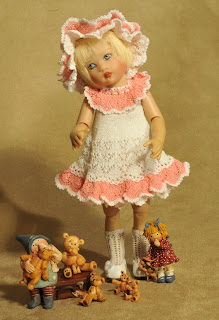Each person has their own working methods, I thought I would share my tricks of the trade I have developed over the years.
Knitting Needles
I highly recommend the Hiya Hiya brand of knitting needles, especially for people who find that their needles have tarnished once used.
My preference are their 24" circular needles, the actual metal needle section measures just over 5"
I buy my needles from Brownberry Yarns in the UK, I have found them most efficient
http://brownberryyarns.co.uk
Hiya Hiya knitting needles are made from stainless steel and the points are not too sharp, I have not had to do anything to the points of the needles I have bought, I work with them ex factory.
Unfortunately their smallest needle is a .07mm, which is the size I find myself using more and more.
I get my smaller size needles from Lacis these come in packs of 5
http://www.lacis.com
It is very important to have a pair of needles a size smaller than the ones used for knitting the garment, ready for any unpicking...."frogging" as it is known..... from the sound "rip it, rip it" of a frog, more importantly for picking up a dropped stitch.
Should you drop a stitch immediately pinch the dropped stitch between the thumb and index finger of your left hand.
This prevents the stitch running down your work.
Pick up the dropped stitch with the smaller size needle then using a crochet hook "knit" the stitch back up to the last row worked.
I find it virtually impossible to unpick rows using the same size needle that I am knitting the garment with, cotton threads do not have much stretch at all. Once a stitch is dropped it seems to shrink and poking your needle into it only makes matters worse in that your knitting becomes distorted.
One also needs a double pointed knitting needle for the technique I call B & T, this is a way of gathering the stitches of the last row together instead of casting off the stitches individually.
B and T tightly technique - mainly used on bonnets.
For this technique the last row is always knitted onto a double pointed needle. Break off thread leaving a tail of at least 30cm, longer if you plan to crochet a decorative edge around the bonnet
Move the stitches to the opposite end of the needle.
Thread your working yarn onto a sewing needle then weave the yarn through the stitches on the needle, you are actually starting from the opposit edge from where the thread is.
Pull together gently and firmly, then fasten off.
Weaving the thread from the opposite end is so much better as the stitches "sit' into place perfectly. Use this thread to sew up the row ends and crochet a decorative edge.





































